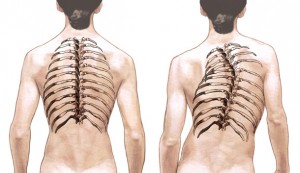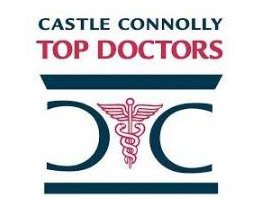Scoliosis refers to an abnormal side-to-side curvature of the spine. As such, scoliosis is a descriptive term and not an actual disease.
You can also visit our microsite about scoliosis treatment at our NJ and NY locations.
A healthy normal spine has curves that help the body balance and move, but these curves occur in the vertical plane. When the spine curves horizontally, doctors call it scoliosis. Some people are born with scoliosis and others develop it because of a medical condition, but the most common type of scoliosis is called adolescent idiopathic scoliosis (AIS). Idiopathic is a medical term that means “of unknown origin.” With AIS, there is no obvious cause for the spinal curvature.

Normal spine (left) – Scoliosis (right)
What you should know about adolescent idiopathic scoliosis
- It typically occurs between the ages of 10 and 18.
- There is no known cause.
- It often worsens during growth spurts.
- Girls get it more often than boys.
- It has been estimated that 2% to 3% of all children between the ages of 10 and 16 have some degree of detectable adolescent idiopathic scoliosis.
Symptoms of adolescent idiopathic scoliosis
Children with adolescent idiopathic scoliosis may have one shoulder higher than the other or move with a pronounced tilt. Other symptoms might include:
- Backache, particularly low back pain
- Fatigue
- Shoulders or hips that are uneven
- Visible curvature of the spine (side-to-side)
However, adolescent idiopathic scoliosis may be painless. For that reason, the ScoliScore test may be particularly useful.
Diagnosis
There are several types of scoliosis, of which AIS is by far the most common. In fact, 80% of scoliosis patients have AIS. Scoliosis differs from kyphosis in the way the spine curves. People with kyphosis have an abnormal front-to-back curving of the spine, while people with scoliosis have an abnormal side-to-side curvature.
At University Spine Center, a physical examination and patient history is the first step in getting an accurate diagnosis. This may include X-rays (front and side views) of the spine and a scoliometer screening, using a special device that helps measure the degree of spinal curvature.
University Spine Center offers the highly advanced ScoliScore diagnostic test to confirm the presence of scoliosis, even in the case of vague or minimal symptoms.
In some cases, University Spine Center may recommend an MRI scan for further examination.
Treatment
Children with adolescent idiopathic scoliosis require the kind of expert treatment they can get at University Spine Center. Early detection and prompt, state-of-the-art treatment will help achieve optimal outcomes.
Some children are treated with a special brace to support the back. This can be particularly effective in children who are still growing. In rare cases, surgery may be required.
If that is the case, the University Spine Center team will discuss surgery options with you. There are minimally invasive surgical procedures that have been very successful. In severe cases, spinal fusion may be required.
The whole patient
University Spine Center recognizes that for adolescent idiopathic scoliosis patients and their families, state-of-the-art care is essential, but professional understanding and compassion matter, too. Scoliosis can affect a person’s self-image and confidence. Adolescent idiopathic scoliosis patients will find a compassionate atmosphere at University Spine Center in addition to expert care and the latest techniques.






